Windows
Windows
When windows 'fail' during a wildfire, fire can move from the outside to the inside of the building, using the failed window as the pathway. Windows fail when the glass breaks and embers and/or flame enters the home, or the frame ignites, both resulting in the ignition of materials in the house. Glass can break as a result of extreme heat on the window, either radiant or flame, or potentially from the impact of wind blown debris.
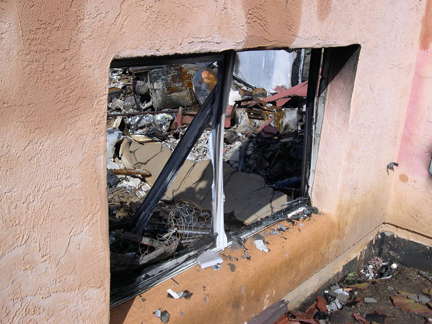
Glass breaks as a result of temperature differences (and the resulting stresses) that develop between the glass that you can see (i.e., look through) and the glass that is protected by the framing material, when a window is exposed to the heat of a fire. If this temperature difference is large enough, and occurs quick enough, cracks will develop as preexisting flaws at the edge of the glass and propagate inward. Theoretically it would be possible to polish the edge of the glass, thereby minimizing the number of edge flaws, and therefore making the glass less vulnerable. Whether this could be a long term solution in terms of maintaining the polished edge during the processing in making the window (inserting in the frame, etc.) hasn't been determined.
As shown in this figure, the all surfaces of the panes of glass in multi-pane windows are numbered, from outside to inside. In this case, for a dual pane window, the surfaces are numbered 1 through 4.

Screens will absorb some of the radiant energy, resulting in less energy being absorbed by the glass. The temperature difference between the protected and exposed glass will be reduced, thereby reducing the vulnerability of the glass. Shutters would provide similar protection (and would also provide protection against the impact of wind blown debris). Screens won't protect against from a flame impingement exposure that could occur if any near home vegetation, or other combustible materials, ignites.
Remembering how each surface of glass is numbered in windows, studies have shown that reflective coatings applied to the #1 surface (the exterior surface of the outer pane) improve the performance of glass since less energy is absorbed (more energy is reflected).
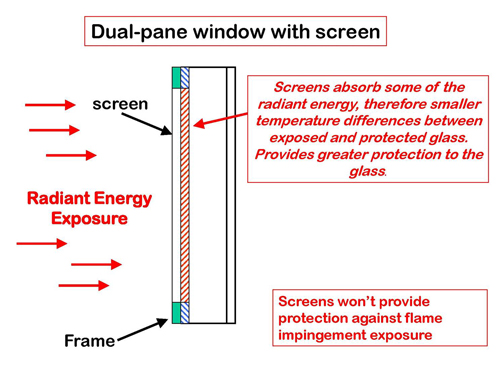
An extreme radiant exposure resulted in the failure of this window ' including both pieces of glass in a dual pane window, and the vinyl clad screen.
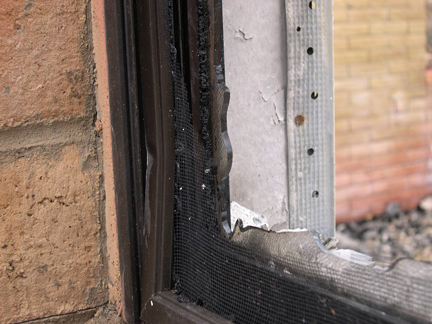
An example of glass failure during window testing conducted at the University of California Fire Research Laboratory. The window was subjected to a flaming exposure from a propane diffusion burner.

An example of frame failure during window testing conducted at the University of California Fire Research Laboratory. The window was subjected to a flaming exposure from a propane diffusion burner.
Research has shown that the horizontal separator (interlock) in single or double hung vinyl windows can deform at low radiant exposures, resulting in gaps forming between the separator and glass unit. The gap allows embers or flames to enter the building. If the separator is reinforced with an aluminum (inner) cross piece, research has also shown that this deformation won't happen.
Vinyl windows have this reinforcement member for other reasons (to resist wind loads, facilitate attachment of hardware, life and safety reasons, including resisting breaking and entering). Vinyl windows that are certified to comply with the AAMA/WDMA/CSA 101/I.S.2/A440 Standard/Specification will include reinforcement in these critical frame/sash members. Look for labeled products indicating certification.
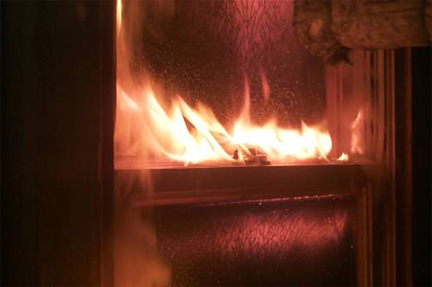
The vinyl deformed in this fixed window as a result of a radiant exposure from a neighboring home that had ignited and was ultimately destroyed. The glass did not break, or fall out as a result of the deformation in the vinyl frame.
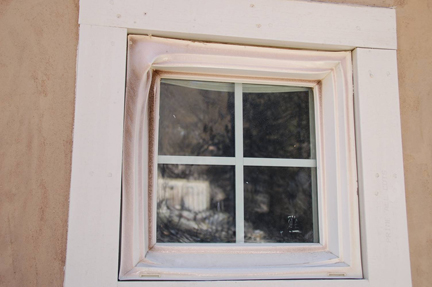
This is an example of an exposure from a radiant panel. The level of exposure is controlled by moving panel closer to or further away from test wall.
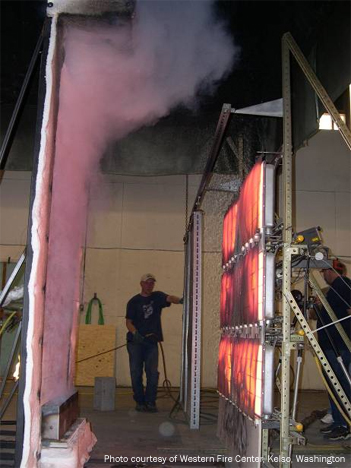
This slide shows the radiant energy generated during a crown fire research study (International Crown Fire Modeling Experiment, 1997-2001, Northwest Territories, Canada ). This figure is from a paper published by Dr. Jack Cohen. The breaking point for different annealed and tempered glass was complied by Dr. Vyto Babrauskas. They are based on publications from a number of researchers, and represent average values.
The radiant exposure was measured about 30 feet from the edge of the fire. In this figure, the y-axis is the measured radiant energy (kW/m2) and the x-axis is time (seconds). Relative to the measurement point, the radiant energy increased and decreased quickly as the fire front went by. Whether glass in a window will break (or combustible siding will ignite) will depend on the radiant energy level, and the exposure time. It is unlikely that tempered glass would have broken given the short exposure time at levels greater than 45 kW/m2.
Note the improvement in performance when tempered glass is used. Tempered glass is about 4 times as strong as single pane annealed, and about 2 times that of a dual pane annealed glass window.
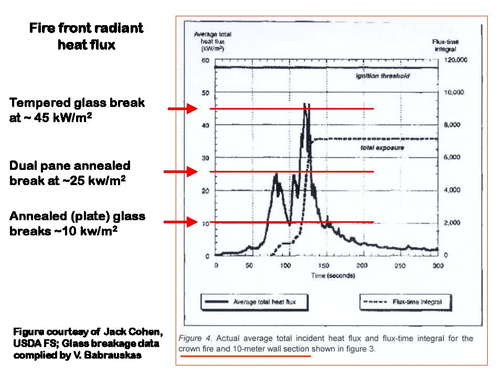
A window with annealed glass. The large piece of glass in this broken window indicative of annealed glass.
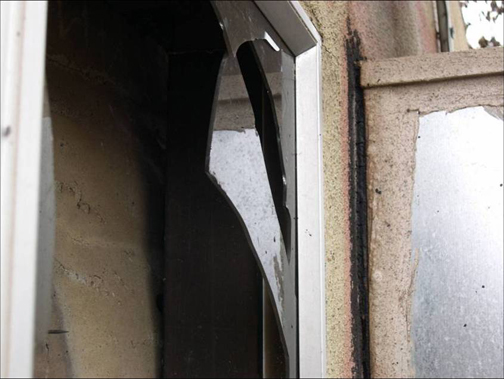
A window containing tempered glass. Note how tempered glass breaks into small chunks.
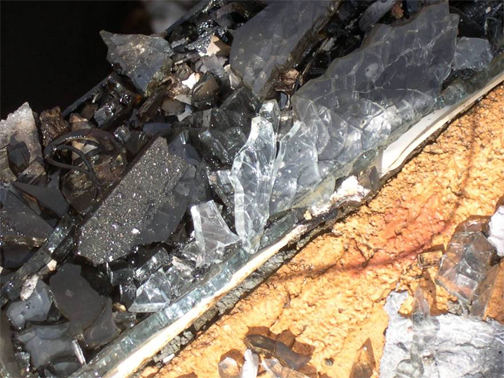
Tempered glass will have a 'bug' etched on the corner of the glass. This can be used to confirm the presence of tempered glass in a window.
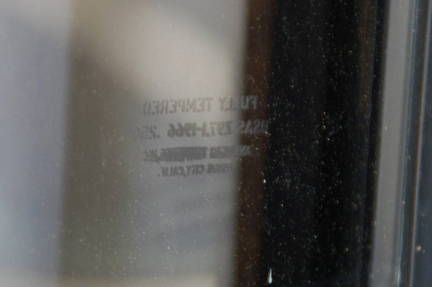
Glass
Presentation on the glass making and tempering process courtesy of Anderson Windows, Stillwater, Minnesota.
California Code Requirements
This is a photograph taken after a 2007 southern California wildfire in the Lake Arrowhead area. The outer pane broke under radiant exposure from a neighbor's house that had ignited and was ultimately destroyed. The window was dual pane with a vinyl frame. Both panes contained (regular) annealed glass.
Tests conducted at the University of California, and in Australia, have shown that under simulated wildland fire exposures, glass is the most vulnerable part of the window. A consumer could be largely 'indifferent' to frame type, and could therefore select based on other criteria (i.e., cost, energy, etc.).
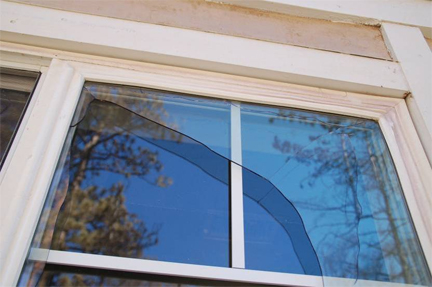
Based on these tests, and others, Chapter 7A of the California Building Code allows use of any framing material. Glass in a window can comply by any one of the following ways:
- By being part of an insulating-glass unit with a minimum of one pane being tempered glass. The tempered member can be either the inner or outer pane, or
- By being a glass block units or be a window that has a fire resistant rating of not less than 20 minutes, or
- By conforming to the performance requirements of SFM Standard test method 12-7A-2 for exterior windows.
The first two options for compliance (minimum dual pane with tempered glass, and glass block) are prescriptive. The California Energy Code has resulted in dual pane windows being the norm in new construction. Currently, building code requires tempered glass for windows in or immediately adjacent to doors, and in windows that are 18' or less from a floor. Chapter 7A requires one of the panes in all dual pane windows to be tempered.
The third option requires testing in a vertical furnace following a specified time-temperature regime. This test results in a largely radiant exposure. After 20 minutes, the exposure temperature would be about 1300 degrees F.
The fourth option (passing SFM standard test 12-7A-2) is a fire penetration test. During this test, a window is subjected to a flame impingement exposure.
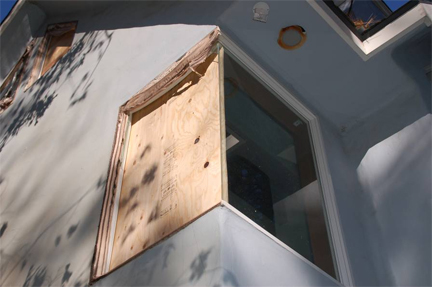
A tempered 'bug' is shown in the upper left corner of the glass in this window. Incorporation tempered glass in the window is the most common way that window manufacturers are complying to Chapter 7A.
Windows that incorporate tempered glass will definitely cost more than those with annealed glass. Tempering requires an additional step in the glass making process.
The added cost will depend on:
- How common is the window opening (if common, then increase will be less)?
- Will the manufacturer decide to only provide dual-pane tempered? If yes, then increase will likely be more.
Depending on these factors, the reported added cost has been 15% and higher.
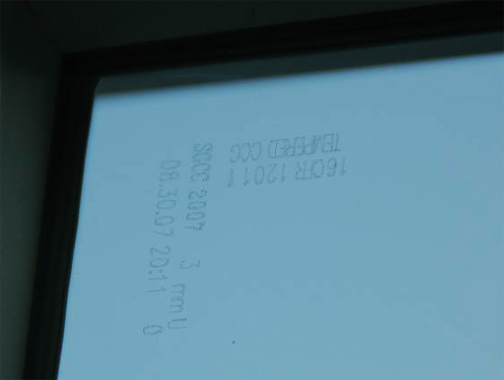
This is a photograph of a vertical furnace used to evaluate the fire performance of walls, and is used to give them their 'hour' rating (e.g., a 1-hour wall, a 2-hr wall). Although this designation has been used by code officials to specify wall construction (siding performance / compliance) in some wildland urban interface areas, it is predominately used to minimize fire spread from floor-to-floor and room-to-room in a single family home, unit-to-unit in multi-family construction, and home-to-home in urban fires.
Chapter 7A doesn't currently rely on the fire resistance ratings (e.g., a one-hour wall) for siding compliance, but the [20-minute exposure] fire resistance rating test is one way for windows and doors to comply.
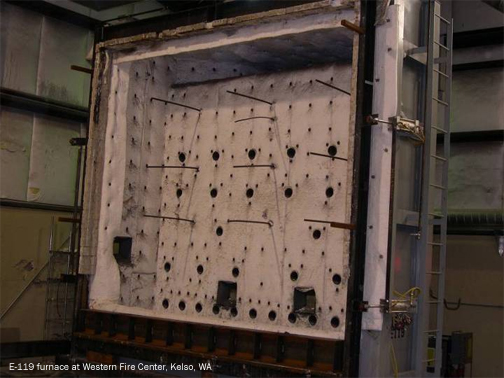
This is the time-temperature curve specified in ASTM E-119. This curve would also be used in the 20-minute window and door tests. The furnace temperature at the end of 20-minutes would be about 1300 degrees F.
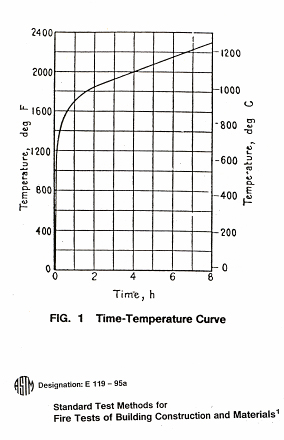
This is a photograph of the window test assembly specified in SFM Standard 12-7A-2. The wall in the plane of the window, and the side walls are clad with gypsum wall board. A gas diffusion burner that provides the flame impingement exposure to the window is placed at the base of the wall. The burner is on for eight minutes.
In order for the window to comply, burn through the window or framing material (into what would the living space of the house) cannot occur.
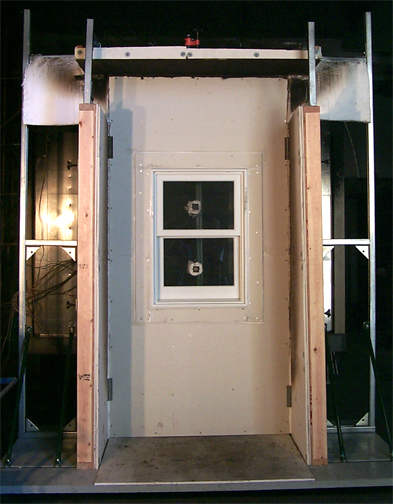
An example from a SFM 12-7A-2 test showing failure by fire penetrating the window by igniting and burning through the frame material.

An example of failure by fire penetrating the window by fire breaking the glass in the window.

For most exterior building components, a current list of products that comply to Chapter 7A provisions are found in the WUI Products Handbook(click on 'NEW PRODUCTS HANDBOOK').
The WUI Products Handbook is published on-line by the Office of the State Fire Marshal as a pdf document. It is updated regularly.
A fee must be paid to OSFM to have a product included in this handbook. Manufacturers are not required to include their compliant products in this, or any, publication. However, this is an easy way to show compliance. Manufacturers wishing to have their product included in this book must have their product tested at an OSFM approved fire laboratory. The test report, prepared by the fire laboratory, must be submitted to OSFM for review and approval.
References
DISCLAIMER: Information in this section was compiled as part of the Building in Wildfire Prone Areas project in 2009. This information may or may not be up to date. More recent information may be available from the Insurance Institute for Business and Home Safety, the California Wildland-Urban Interface Code Information, and the CAL FIRE Wildland Hazard/Building Codes site.



